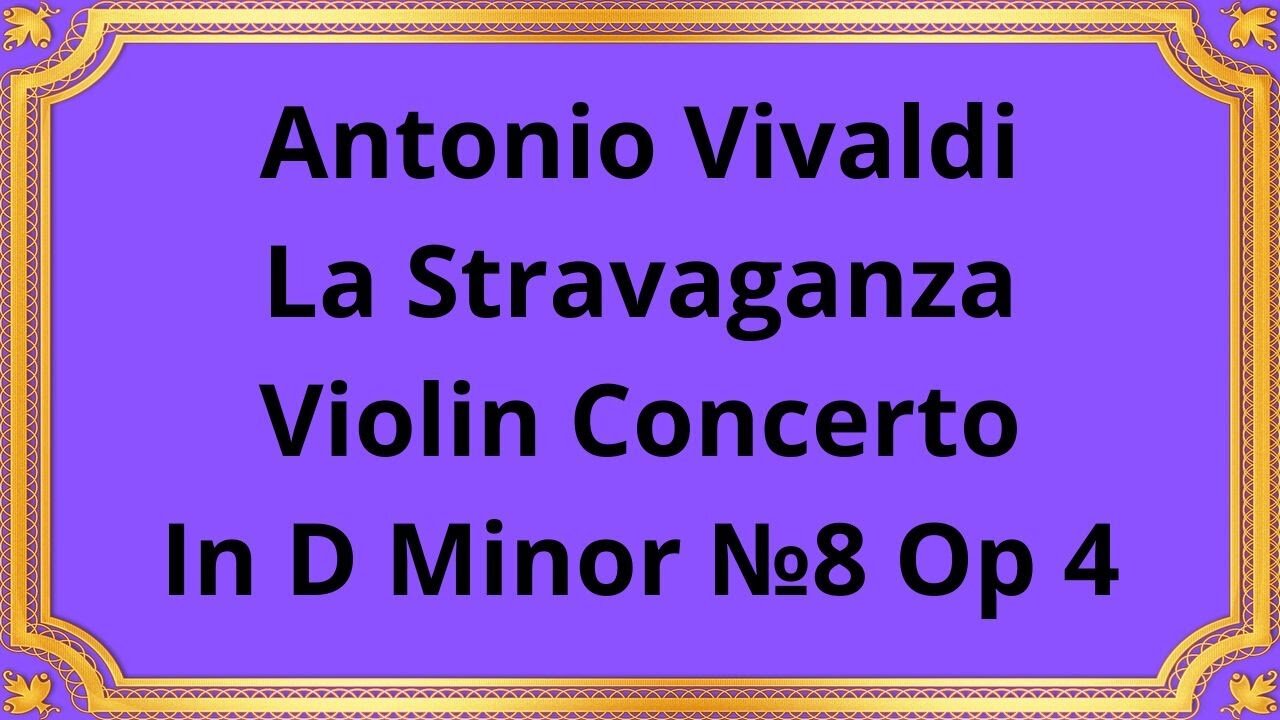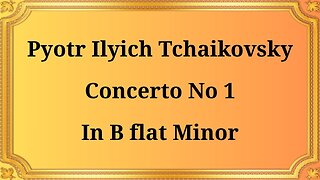Premium Only Content

Antonio Vivaldi La Stravaganza Violin Concerto In D Minor №8 Op 4
#classicalmusic #Vivaldi #LaStravaganza #ViolinConcerto #DMinor #Op4 #musiccomposition #baroquemusic #classicalcomposers #concertomusic #orchestralmusic
Antonio Vivaldi; Reinhold Barchet; Helma Elsner; Pro Musica Orchestra Stuttgart; Rolf Reinhardt
Antonio Vivaldi, a prominent composer of the Baroque era, has left an indelible mark on classical music. Among his vast repertoire, the La Stravaganza Violin Concerto in D Minor, No. 8, Op. 4 stands out as a captivating piece that showcases Vivaldi's mastery of the concerto form and his ability to evoke a wide range of emotions.
Antonio Vivaldi composed the La Stravaganza Violin Concerto in D Minor, No. 8, Op. 4 during the early 18th century. This period was characterized by the flourishing of the concerto genre, with its focus on virtuosic solo performances and the interaction between the soloist and the accompanying orchestra. Vivaldi's contributions to this genre were groundbreaking, and this particular concerto exemplifies his innovative style.
The La Stravaganza Violin Concerto in D Minor, No. 8, Op. 4 adheres to the traditional three-movement structure of a concerto: fast-slow-fast. The opening movement, marked Allegro, sets a dramatic and intense tone. The solo violin takes center stage, engaging in a spirited dialogue with the accompanying orchestra. The second movement, marked Largo, provides a contrasting mood, offering a moment of tranquility and introspection. Here, the solo violin showcases Vivaldi's gift for crafting expressive melodies and evoking deep emotions. The final movement, marked Allegro, returns to the energetic and lively nature of the opening, featuring virtuosic passages and intricate interplay between the soloist and the orchestra.
The La Stravaganza Violin Concerto in D Minor, No. 8, Op. 4 is distinguished by Vivaldi's flair for creating dynamic and evocative music. The opening Allegro movement captivates listeners with its intense rhythms, intricate ornamentation, and fiery melodies. The Largo movement, in contrast, offers a moment of introspection, with its poignant melodies and expressive phrasing. The final Allegro movement brings a sense of exhilaration, with its lively tempo, virtuosic violin passages, and spirited exchanges between the soloist and the orchestra.
The La Stravaganza Violin Concerto in D Minor, No. 8, Op. 4 is a testament to Vivaldi's innovative approach to composition and his ability to captivate audiences with his expressive melodies and technical brilliance. Its enduring popularity is a testament to its musical brilliance. Vivaldi's influence on subsequent generations of composers cannot be overstated, as his unique style and mastery of the concerto form paved the way for further developments in classical music.
Conclusion:
Antonio Vivaldi's La Stravaganza Violin Concerto in D Minor, No. 8, Op. 4 is a captivating musical composition that exemplifies the genius of this Baroque era composer. Its three-movement structure, expressive melodies, and virtuosic violin passages continue to captivate audiences and inspire musicians worldwide. By exploring the historical context, musical structure, and lasting impact of this concerto, we gain a deeper appreciation for Vivaldi's contributions to the world of classical music and the enduring beauty of his compositions.
You have the opportunity to support the channel:
https://destream.net/live/RadSiarAl/donate
https://www.buymeacoffee.com/6355radsiaral
-
 31:06
31:06
Classical music_Music Inspiration
9 days agoPyotr Ilyich Tchaikovsky Piano Concerto No. 1 in B-flat minor
411 -
 LIVE
LIVE
The Bubba Army
2 days agoAlligator Alcatraz Closed?! - Bubba the Love Sponge® Show | 8/11/25
5,090 watching -
 29:03
29:03
DeVory Darkins
14 hours ago $6.40 earnedDemocrat Governors painfully HUMILIATED Trump drops BRUTAL WARNING for DC officials
7.03K53 -
 14:44
14:44
Preston Stewart
18 hours ago $1.15 earnedTrump's Cartel Crackdown
5.08K6 -
 1:05:58
1:05:58
Sarah Westall
15 hours agoForces Creating Massive Instability Worldwide: US, Ukraine, China, Israel, Colonel Douglas Macgregor
15.3K31 -
 LIVE
LIVE
BEK TV
1 hour agoTrent Loos in the Morning - 8/11/2025
85 watching -
 3:45:16
3:45:16
Badlands Media
1 day agoThe Narrative Ep. 34: The World Eater
111K41 -
 29:39
29:39
Afshin Rattansi's Going Underground
23 hours agoProf. Jeffrey Sachs: Will The Trump-Putin Meeting End the Ukraine Proxy War and Avert Nuclear War?
24.8K89 -
 9:48:25
9:48:25
Rallied
16 hours ago $23.18 earnedWarzone Solo Challenges All Day w/ Ral
120K8 -
![Aug Day #10 of RCP 🤟 [FR/ENG] 🫶 Some Fortnite then Demos then continue on StarRupture 🫶 🤟](https://1a-1791.com/video/fww1/81/s8/1/O/0/c/-/O0c-y.0kob-small-Aug-Day-10-of-RCP-FRENG-Som.jpg) 4:24:45
4:24:45
Deaf Gamer Girl
14 hours agoAug Day #10 of RCP 🤟 [FR/ENG] 🫶 Some Fortnite then Demos then continue on StarRupture 🫶 🤟
63.3K3